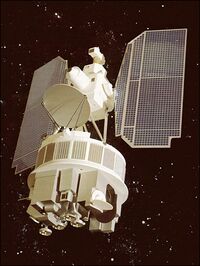Engineering:Nimbus 6
From HandWiki
Short description: Former U.S. meteorological satellite
 Artist rendering of the Nimbus 6 | |
| Mission type | Weather satellite |
|---|---|
| Operator | NASA |
| COSPAR ID | 1975-052A |
| SATCAT no. | 7924 |
| Spacecraft properties | |
| Manufacturer | RCA Astrospace |
| Launch mass | 827 kg (1,823 lb) |
| Dry mass | 586 kg (1,292 lb) |
| Dimensions | 3.04 m × 1.52 m × 3.96 m (10.0 ft × 5.0 ft × 13.0 ft) |
| Start of mission | |
| Rocket | Delta 2910 577/D93 |
| Launch site | Vandenberg Air Force Base SLC-2W |
| End of mission | |
| Last contact | March 29, 1983[1] |
| Orbital parameters | |
| Reference system | Geocentric |
| Regime | Low Earth |
| Perigee altitude | 1,093 kilometers (679 mi) |
| Apogee altitude | 679 kilometers (422 mi) |
| Inclination | 100° |
| Period | 107 minutes |
| Epoch | June 12, 1975 |
Nimbus 6 (also called Nimbus G) was a meteorological satellite. It was the sixth in a series of the Nimbus program.
Launch
Nimbus 6 was launched on June 12, 1975, by a Delta rocket from Vandenberg Air Force Base in California , United States. The satellite orbited the Earth once every 107 minutes, at an inclination of 100°. Its perigee was 1,093 kilometers (679 mi) and its apogee was 1,101 kilometers (684 mi).[2]
Instruments
- Earth Radiation Budget (ERB)
- Electrically Scanning Microwave Radiometer (ESMR)
- High-Resolution Infrared Radiation Sounder (HIRS)
- Limb Radiance Inversion Radiometer (LRIR)
- Pressure Modulated Radiometer (PMR)
- Scanning Microwave Spectrometer (SCAMS)
- Temperature-Humidity Infrared Radiometer (THIR)
- Tracking and Data Relay Experiment (T+DRE)
- Tropical Wind Energy Conversion and Reference Level Experiment (TWERLE)
See also
References
- ↑ "Satellite: Nimbus-6". OSCAR - Observing Systems Capability Analysis and Review Tool. World Meteorological Organization. July 28, 2015. https://www.wmo-sat.info/oscar/satellites/view/320.
- ↑ "Nimbus 6". National Space Science Data Center. NASA Goddard Space Flight Center. https://nssdc.gsfc.nasa.gov/nmc/spacecraft/display.action?id=1975-052A.
External links
 |

